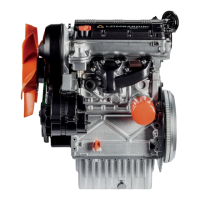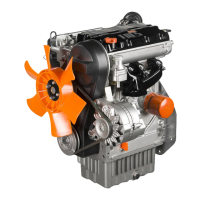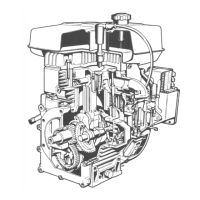- 11 - Workshop Manual LDW CHD _ cod. 1.5302.345 - 6° ed_rev. 05
1
General remarks and safety information
Never carry out any operation whilst the engine is running.
• Thecoolantuidcircuitisunderpressure.
Never carry out any inspections until the engine has cooled and even in this case, only open the radiator plug or expansion
chamber with the utmost caution, wearing protective garments and goggles. If there is an electric fan, do not approach the en-
gine whilst it is still hot as the fan could also start operating when the engine is at a standstill.
Only clean the coolant system when the engine is at a standstill.
• Whencleaningtheoil-cooledairlter,makesurethattheoldoilisdisposedofinthecorrectwayinordertosafeguardtheen-
vironment.
Thespongylteringmaterialinoil-cooledairltersmustnotbesoakedinoil.
Thereservoiroftheseparatorpre-ltermustnotbelledwithoil.
• The oil must be drained whilst the engine is hot (oil T ~ 80°C).
Particular care is required to prevent burns.
Do not allow the oil to come into contact with the skin.
• Payattentiontothetemperatureoftheoillterwhenthelteritselfisreplaced.
• Onlycheck,topupandchangethecoolantuidwhentheengineisoffandcold.
Takecaretopreventuidscontainingnitritesfrombeingmixedwithothersthatdonotcontainthesesubstancessince"Nitro-
samine", dangerous for the health, can form.
Thecoolantuidispollutingandmustthereforebedisposedofinthecorrectwaytosafeguardtheenvironment.
• During operations that involve access to moving parts of the engine and/or removal of rotating guards, disconnect and insula-
te the positive wire of the battery to prevent accidental short-circuits and to stop the starter motor from being energized.
• Only check belt tension when the engine is off.
• Only use the eyebolts installed by LOMBARDINI to move the engine.
These lifting points are not suitable for the entire machine; in this case, the eyebolts installed by the manufacturer should be
used.
GENERAL SAFETY DURING OPERATING PHASES
– The procedures contained in this manual have been tested and selected by the manufacturer’s technical experts, and hence
are to be recognised as authorised operating methods.
– Some tools are normal workshop ones, while others are special tools designed by the Manufacturer of the engine.
– All tools must be in good working condition so that engine components are not damaged and that operations are carried out
properly and safely.
– It is important to wear the personal safety devices prescribed by work safety laws and also by the standards of this manual.
– Holesmustbelinedupmethodicallyandwiththeaidofsuitableequipment.Donotuseyourngerstocarryoutthis
operation to avoid the risk of amputation.
– Some phases may require the assistance of more than one operator. If so, it is important to inform and train them regarding
the type of activity they will be performing in order to prevent risks to the health and safety of all persons involved.
– Donotuseammableliquids(petrol,diesel,etc.)todegreaseorwashcomponents.Usespecialproducts.
– Use the oils and greases recommended by the manufacturer.
Do not mix different brands or combine oils with different characteristics.
– Discontinue use of the engine if any irregularities arise, particularly in the case of unusual vibrations.
– Do not tamper with any devices to alter the level of performance guaranteed by the manufacturer.
SAFETY AND ENVIRONMENTAL IMPACT
Every organisation has a duty to implement procedures to
identify,assessandmonitortheinuenceofitsownactivities
(products, services, etc.) on the environment.
Procedures for identifying the extent of the impact on the envi-
ronment must consider the following factors:
- Liquid waste
- Waste management
- Soil contamination
- Atmospheric emissions
- Use of raw materials and natural resources
- Regulations and directives regarding environmental impact
In order to minimise the impact on the environment, the manu-
facturer now provides a number of indications to be followed
by all persons handling the engine, for any reason, during its
expected lifetime.
- All packaging components must be disposed of in accor-
dance with the laws of the country in which disposal is
taking place.
- Keep the fuel and engine control systems and the exhaust
pipesinefcientworkingordertolimitenvironmentaland
noise pollution.
- When discontinuing use of the engine, select all compo-
nents according to their chemical characteristics and dispo-
se of them separately.

